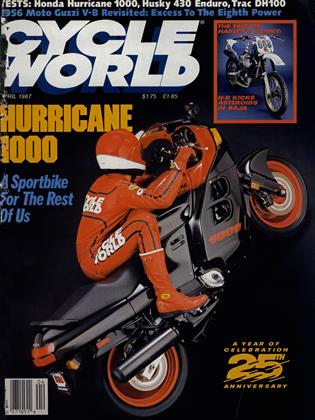THE HISTORY
THE EIGHT
The year was 1956. The motorcycle was a Moto Guzzi. The engine was unbelievable.
MIKE NICKS
EARLY IN 1957. BILL LOMAS. THEN THE SENIOR rider on Moto Guzzi's Grand Prix team, attacked the 10-kilometer standing-start world record for 500cc motorcycles. The Italian authorities, ever cooperative when the honor of a national team was involved, closed a narrow but straight section of the Appian Way near Rome for the attempt, and Lomas took less than l50 seconds to cover the 6.21 miles and capture the record. His average speed was 151 miles per hour—from a standstill, remember—and Guzzi technicians calculated that his terminal speed was 175 mph.
What was remarkable about this record was that it was set not by a specially constructed speed-record machine that was enclosed in cigar-shaped streamlining and had the rider lying horizontally, but by a conventional roadracing motorcycle. There was, however, something unique about Lomas’ machine: It had eight cylinders. The engine was a jewel-like V-Eight that had dual overhead camshafts on each bank of cylinders, with eight tiny carburetors and eight separate float chambers nestled between the cylinder banks. The 44mm bore and 41mm stroke gave a total capacity of 499cc and an individual cylinder displacement of 62.3cc. The choke size of each Dell'Orto carburetor was just 20mm.
The arrival of this incredible machine, with its haunting, high-pitched exhaust note, convulsed the Grand Prix scene in the Fifties. In 1954—the year in which the V-Eight was designed by Moto Guzzi’s brilliant engineer, Giulio Carcano—single-cylinder Nortons, whose origins lay in the 1920s, were still winning 500cc GP races. Gilera was the 500cc world champion with its four-cylinder racer, and another Italian factory, MV Agusta, was developing a similar four-cylinder challenger. But for most motorcyclists, both racers and road riders, a twin-cylinder engine was the most they could hope to experience. The only four-cylinder machine being made in any quantity throughout the world was the lOOOcc Ariel Square Four, a British touring bike of exceptional bulk and unexceptional performance.
In his battle to beat the Gilera and MV factories, Carcano rejected Singles and Twins as too slow, and decided that his rivals already had too great a lead in building four-cylinder engines. And anyway, he wanted to try something different. But an inline-Six would be too wide, and a V-Six had inherent balance problems that made it less than ideal as a racing engine.
And so a V-Eight seemed the answer. It would permit high engine speeds, excellent balance and good weight distribution, and offer more valve area for any given displacement than engines with fewer cylinders.
In April of 1955, only six months after first putting drawing pen to paper, Carcano had a complete engine running on the test bench—an amazing feat, considering that this was not an era when motorcycle factories had vast research and development resources at their disposal. Carcano created his V-Eight in a racing department staffed only by two other engineers, a solitary engine builder and 12 mechanics. And along the way, they also had to manage a Grand Prix team that was successful enough to win the 350cc world championship for five consecutive years (from 1953 to 1957) with elegant, lightweight, single-cylinder machines.
Carcano’s V-Eight competed in its first GP in 1956, but development problems prevented it from finishing
a single race that year. During the following winter, the engine completed 1000 miles of reliability testing, and for the 1957 season it was delivering 80 horsepower at the crankshaft at between 12,000 and 13,000 rpm. This was a prodigious output for the rider to feed through the bike’s skinny rear tire, which was just over three inches wide, fully treaded and, by today’s standards, rock-hard in compound. Yet the machine was capable of approaching l 80 mph because of the efficiency of its “dustbin” fairing that enclosed the front wheel. This form of streamlining was banned in 1958 because of its vulnerability to crosswinds; but on the Guzzi, the fairing allowed the V-Eight to be almost as fast as modern GP two-strokes in terms of top speed.
Sadly, fate decreed that the V-Eight was never to fulfill its potential. In 1957, a series of injuries among Guzzi’s riders—chiefly to the 29-year-old Lomas, who broke a collarbone and fractured his skull in two accidents on 350cc machines—prevented the bike from threatening the Fours. And at the end of 1957, Moto Guzzi, along with most of the other Italian factories, pulled out of racing as the world motorcycle market suffered one of its periodic declines.
With that pullout, the V-Eight. the world’s most fantastic racing machine, was wheeled into a shed, where dust, darkness and rust were to become its main companions for the next three decades.
 View Full Issue
View Full Issue
More From This Issue
-
 Editorial
EditorialThe Best of Rides, the Worst of Bikes
April 1987 By Paul Dean -
 At Large
At LargeAmerican Style In France And Finland
April 1987 By Steven L. Thompson -
 Letters
LettersLetters
April 1987 -
 Roundup
RoundupLending History A Helping Hand
April 1987 By Camron E. Bussard -
 Roundup
RoundupLetter From Japan
April 1987 By Kengo Yagawa -
 Roundup
RoundupLetter From Europe
April 1987 By Alan Cathcart









